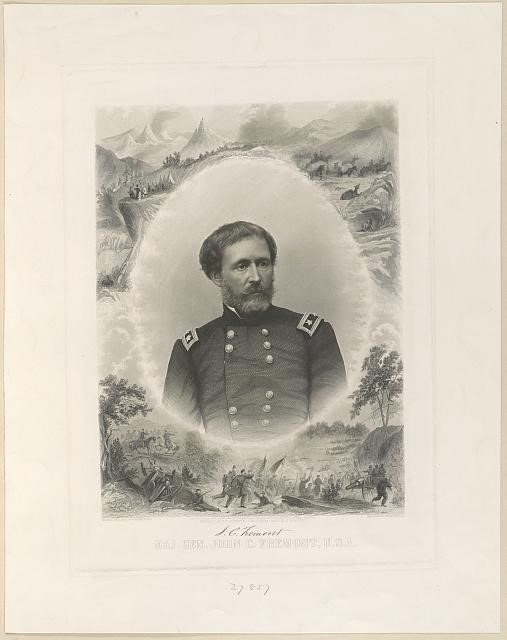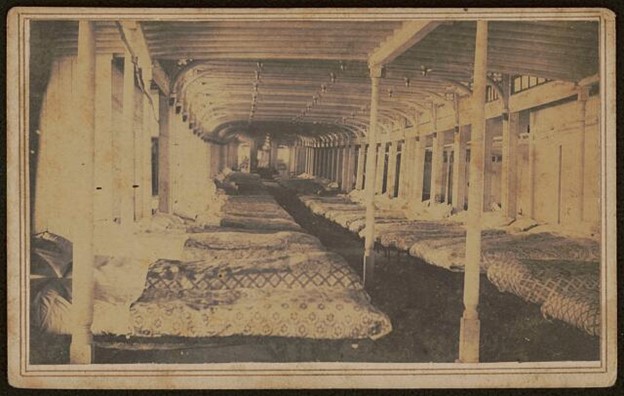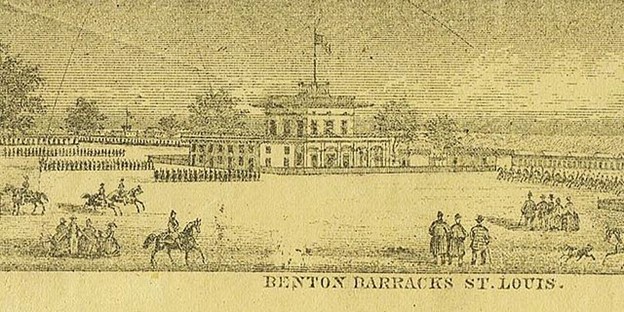Table of Contents
The United States Sanitary Commission (USSC) was one of the most prominent civilian relief associations in the Civil War. They sent surgeons, nurses, and supplies to the front to assist the Army in medical operations. The USSC had also outfitted several steamers to serve as hospital ships for Eastern campaigns, specifically for the Peninsula Campaign. As the fighting spread West, so did relief organizations. Modeling itself off the USSC, Union General John C. Fremont, Reverend William Greenleaf Eliot, James E. Yeatman, and Dorothea Dix established the Western Sanitary Commission (WSC) in August 1861. The WSC headquarters were in St. Louis, Missouri and were established just in time for their first trial by fire. Much like the role of the USSC, the WSC would set up hospitals, administer medical services, house orphans, and improve sanitation in camps.[1]

Just a few days after the headquarters opened, the wounded from the Battle of Wilson’s Creek were sent to St. Louis and quickly overwhelmed the few hospitals in the city. On September 10, the commission opened its first hospital in a rented five-story building on the corner of Fifth and Chesnut Streets.[2] Surgeon John T. Hodgen, U.S.V. was appointed as the surgeon in charge of the hospital and had a fully equipped staff at his disposal. “City General Hospital,” as it would become known, was a 500-person capacity hospital in a convenient location. This first hospital, while it was said to be the best managed hospital in the city, had a 14.5 percent mortality rate – notably higher than other general hospitals throughout the war which rarely crested 10 percent.[3]
As more wounded made their way to St. Louis from various Western Theater battlefields, the WSC established another five hospitals throughout the city; the Good Samaritan, the Fourth Street or Eliot Hospital, the Pacific, the Post, and the Convalescent Hospitals at Benton Barracks.[4] However, while the WSC was performing the same jobs as the USSC, the WSC did not receive any federal funding. Instead, the WSC relied on private funding from donors primarily from New England and California. These donors would send a variety of goods from cash to care packages full of clothes and supplies.[5]
In February 1862, General Ulysses S. Grant fought at Fort Donelson. The battle was a Union victory, however, Grant’s forces suffered more killed and wounded than his Confederate counterparts. Upon hearing of the battle’s conclusion, the WSC began making its way to the hospitals surrounding the Fort. Along the way, the WSC brought a small fleet of ships converted into hospital transports such as the hospital ship City of Louisiana.
One month after the Battle of Fort Donelson, the Battle of Pea Ridge was fought in March. The battlefield was sparsely populated, and the infrastructure was nearly non-existent. The battlefield was also roughly 250 miles away from the nearest railhead through poor, snow covered roads full of guerilla fighters. Despite this, the WSC sent some of its stores of medical supplies to nearby Springfield, Missouri and locations in the surrounding area where wounded soldiers convalesced. Several surgeons and nurses accompanied the medical supplies in order to ensure they arrived at the hospitals in need.

From February 29 through April 8, 1862, Federal and Confederate steam ships engaged each other for control of Island No. 10, with the Union forces laying siege to the island that March. In the ensuing Union victory, the CSS Red Rover was captured by the USS Mound City and then converted by the WSC and the Quartermaster Department into a hospital ship to be used in campaigns along the Mississippi River. The Quartermaster Department supplied the Red Rover with “…a complete outfit of beds, bedding, furniture, sanitary stores, medical dispensary, etc.”[6] The WSC was able to supply “the services of surgeons, an apothecary, steward and nurses… the boat placed in charge of Dr. Geo. H. Bixby, surgeon, and Dr. Hopkins, assistant surgeon.”[7] The Red Rover would become one of the most well-known hospital ships of the Civil War.

One year later in 1863, Major General Ulysses S. Grant took his Army of the Tennessee to capture Vicksburg, Mississippi. The Vicksburg campaign resulted in over 37,000 casualties, 4,700 of those were Union wounded or killed. The WSC brought medical supplies via riverboat to the Union lines while also trying to keep the camps as sanitary as possible to reduce the amount of disease. Hospitals in St. Louis were also preparing for the incoming wounded from Vicksburg. One such hospital was at Benton Barracks northwest of St. Louis. Surgeon Ira Russell was placed in charge of the hospital beginning in March of 1863. Within the first three months of its operation, the hospital received 2,042 with a mortality rate of 4.5 percent. Over the next year, the hospital received a total of 4,898 patients and a mortality rate of 7.1 percent.[8]
Several months later in October 1863, representatives from the WSC traveled across the Mississippi Valley after hearing reports of poor conditions in Freedmen’s camps. As the war turned to favor Union advances across the deep South, Union soldiers began liberating plantations and sending the refugees behind the lines for food, shelter, and medical care, or at least that was the intention. In a letter to President Abraham Lincoln in November 1863, senior WSC members wrote, “there are probably not less than fifty thousand, chiefly women and children, now within our lines between Cairo and New Orleans, for whom no adequate provision has been made.”[9]
Staying true to the mission of the WSC, the letter did not seek to investigate the cause of the horrible conditions of these camps, but rather to just fix the problem. Despite calls for Congress to act, the commission knew that “… from past experience, a good many months will elapse before its final action, and there will still remain a great deal that properly belongs to private charity, and for which legislation cannot provide.”[10]
Disease spread rapidly throughout these camps, and the formerly enslaved people were forced into labor for the Union without compensation according to WSC leaders. Camp Ethiopia was established to house the women and children mostly after the Battle of Helena. The residents of this camp were given heavily used tents in poor conditions or lived in nearby caves, none of which were adequate for the coming winter.[11] In January 1863, WSC member Maria R. Mann arrived at Helena with “a large supply of sanitary stores, clothing, hospital goods, furniture, stove, &c., to fit up a better hospital for the sick of this class, and to minister generally to their wants.”[12] The conditions initially seen in Camp Ethiopia were also observed in other Freedmen’s camps and refugee camps across the South.
Through various donations primarily from New England totaling $30,000 in supplies and $13,000 in cash[13], the WSC was able to outfit camps across the South with the necessary equipment and provisions to provide better conditions for the refugees. The WSC seemed to be one of the few entities concerned for the care of formerly enslaved people across the South. Despite this, disease still spread rapidly, especially smallpox as the vast majority of former slaves were not vaccinated. However, doctors, nurses, and chaplains still worked to better the health of the formerly enslaved as it was their duty to answer the call of those in need.
The Civil War brought forth both the best and the worst this nation had to offer in the mid-19th century. The story of the WSC is one of the better ones. For the duration of the Civil War, the WSC provided excellent medical care to the wounded soldiers of the Western Theater despite not having the same access to materials and resources as the USSC. Through the generous donations of citizens across the nation, the WSC was able to keep hospital stores to acceptable levels and served with distinction in the medical community. The WSC disbanded in 1865 but its then former members would continue to serve with the Freedmen’s Bureau and provide medical care to the freed people.
About the Author
Michael Mahr is the Education Specialist at the National Museum of Civil War Medicine. He is a graduate of Gettysburg College Class of 2022 with a degree in History and double minor in Public History and Civil War Era Studies. He was the Brian C. Pohanka intern as part of the Gettysburg College Civil War Institute for the museum in the summer of 2021. He is currently pursuing a Masters in American History from Gettysburg College and the Gilder Lehrman Institute.
Sources
[1] “A Spotlight on a Primary Source by James E. Yeatman.” The Western Sanitary Commission reports on suffering in the Mississippi Valley, 1863 | Gilder Lehrman Institute of American History, n.d. https://www.gilderlehrman.org/history-resources/spotlight-primary-source/western-sanitary-commission-reports-suffering.
[2] Forman, J. G. The Western Sanitary Commission; a Sketch of Its Origin, History, Labors for the Sick and Wounded of the Western Armies, and Aid Given to Freedmen and Union Refugees, with Incidents of Hospital Life. St. Louis: R.P. Studley & Co., 1864. Pg 8
[3] Ibid., 9.
[4] Ibid., 10.
[5] Ibid., 11-12.
[6] Forman, J. G. The Western Sanitary Commission; a Sketch of Its Origin, History, Labors for the Sick and Wounded of the Western Armies, and Aid Given to Freedmen and Union Refugees, with Incidents of Hospital Life. St. Louis: R.P. Studley & Co., 1864. Pg 54
[7] Ibid,. 54
[8] Ibid,. 73
[9] Yeatman, James E. (1818-1901). Appeal from the [[Western Sanitary Commission]] to President Abraham Lincoln regarding the condition of freed slaves. [Broadside]. At: Place: The Gilder Lehrman Institute of American History. GLC01545.11. Available through: Adam Matthew, Marlborough, American History, 1493-1945. http://www.americanhistory.amdigital.co.uk.ezpro.cc.gettysburg.edu:2048/Documents/Details/GLC01545.11
[10] Yeatman, James E. (1818-1901). Appeal from the [[Western Sanitary Commission]] to President Abraham Lincoln regarding the condition of freed slaves. [Broadside]. At: Place: The Gilder Lehrman Institute of American History. GLC01545.11. Available through: Adam Matthew, Marlborough, American History, 1493-1945. http://www.americanhistory.amdigital.co.uk.ezpro.cc.gettysburg.edu:2048/Documents/Details/GLC01545.11
[11] Forman, J. G. The Western Sanitary Commission; a Sketch of Its Origin, History, Labors for the Sick and Wounded of the Western Armies, and Aid Given to Freedmen and Union Refugees, with Incidents of Hospital Life. St. Louis: R.P. Studley & Co., 1864. Pg 111
[12] Ibid,. 112
[13] Ibid,. 114


